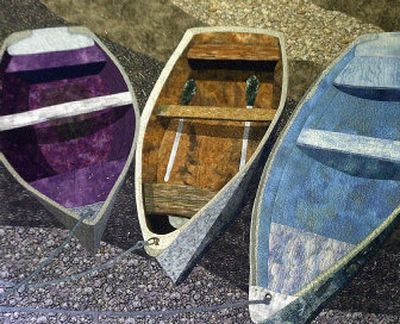Quilting queen

The setting is positively idyllic … a lovely country home adjoining Farragut State Park, immaculate grounds and deer-proofed gardens, two white-tailed deer keeping a polite distance … mainly due to the vigilance of Foster, the Australian shepherd at our feet.
Her sewing room upstairs is just as organized and peaceful. “I expected more chaos a week before your ‘queen for a day’ debut. Everything’s so tidy,” I said. “Oh, tidy doesn’t even begin to describe it,” she said.
Jean Van Bockel, the featured quilter of this year’s North Idaho Quilters’ show, seems as serene as her surroundings. Tall and slim, with startlingly blue eyes, she is a gracious hostess, delighted to share her work and her stories.
Arless Scheet, co-chairwoman of the NIQ show, says, “It was Jean’s time. Our committee of 18 chooses a featured quilter based on the quality of her work. Jean is local, prolific, published and so talented. She does the best hand applique we’ve ever seen.”
Over a picnic lunch set out around the backyard fire pit, I had the privilege of delving into her history.
Q. When and where did you start quilting?
A. My mother only sewed on demand, so she sent me to 4-H to learn how to sew. Then in 1985, when my youngest child started first grade, I started quilting. We were living in Snohomish, Wash., and I joined a quilting group. Quilting is a wonderful hobby in that it comes complete with very good support groups.
Q. Currently, what’s your major professional focus?
A. I’ve started designing new quilts and writing pattern books for Martingale Press. I collaborated with Pam Mostek on the first one, called “Quilts” from Larkspur Farm, which came out in 2002. The second book, “Meadowbrook Quilts,” was published the next year, and the third one, “Polka Dot Kids,” is due out this fall.
Q. What was the inspiration for the books?
A. The first book was “set” on Larkspur Farm, which is an actual farm in Western Washington. “Meadowbrook Quilts” is a seasonal book, full of nature images from the Meadowbrook area south of Coeur d’Alene. And my new one is all quilts for kids, stemming from my son’s childhood blanket, which he called his “nanny.” Every quilt in this new book contains at least one circle, spot or polka dot fabric.
Q. What would you say was the strangest inspiration for a quilt?
A. That would have to be “Chicken Massacre.” We were living out at Meadowbrook, and raising Rhode Island Reds. My husband came home one day to a literal massacre. The whole yard was littered with feathers and the bloody carcasses of 11 of our prize chickens. Apparently our Chesapeake, Cedar, and two of his cohorts, Ruby, the neighbor’s black Lab, and Chase, a little wire-haired terrier, had had a field day while we were at work. The quilt is basically blood-red, and includes all the players, including a couple silent witnesses.
Q. What would you say is the common thread that runs through all of your designs?
A. I don’t have a trademark “look” that identifies my quilts as mine. That’s something I hope to develop in the near future. I’ve been somewhat of a quilting chameleon, experimenting with lots of different looks. But the publisher I work with focuses on patterns for beginning- to intermediate-level quilters, and the message is that anyone can quilt. I think the invention of the rotary cutter and the long-arm quilting machine has enabled anyone with a desire to make a quilt to be able to do so.
Q. What’s your production schedule like?
A. For each book, I design about 18 projects. I send half a dozen finished pieces to the publisher for consideration, with the others drafted in colored pencil. After they’ve accepted a proposal, I have about five months to finish all the pieces and patterns. So the process consumes most of my year. It’s a challenge to find time for my own work.
Q. What do you hope visitors to the NIQ quilt show next weekend will come away with?
A. My collection has great variety. There’s something for everyone there. Until I develop a unique “look,” I guess variety will be my statement.
Q. Do you sell your quilts?
A. I’ve only sold one, a piece featuring three large rowboats. Afterward, my husband told me that it was the one piece he really liked. So I’ve reproduced it for him, and it’ll be featured at the show.
Q. If it’s true that “the one who dies with the most fabric wins,” do you think you have a chance at first prize?
A. I could probably work until I die with what I have now, but you can never have too much fabric! One of my friends was saying the other day that she wished she could turn in all her fabric and get a car!
Q. Where will you be with your quilting in the next five years?
A. I can envision half a dozen more books with Martingale, and I hope to enter pieces in more national shows, and more juried shows. I’d like to create unique pieces that let the fabrics do the work. I’d also like to work toward my own “look,” and my personal best. I’m probably the only person who’d like an epitaph that says, ‘Gee, I wish I’d spent more time at the office.’ I’ve led a charmed life, and it just keeps going!